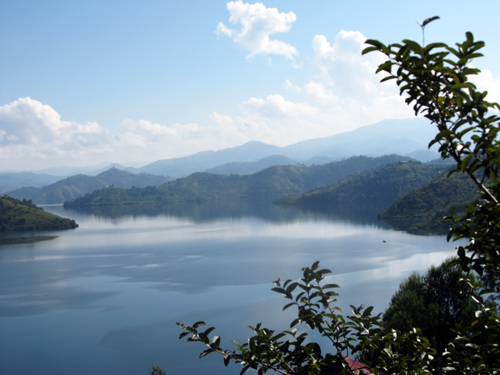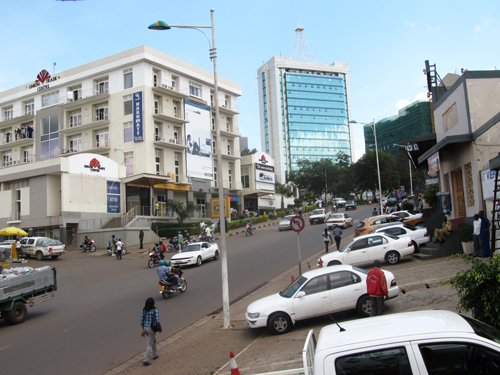
For U of G master’s student Brad Crawford’s guide during his three-week visit to Rwanda, the genocide was personal. “Our guide’s aunt and uncle were afraid they would be killed, so they sought refuge in their church,” Crawford says. “Their priest locked the doors and had the building bulldozed, killing them and the rest of his own congregation. People went to the church seeking safety, but it just made it easier to kill them.”
The wreckage is still there, a permanent reminder.
In fact, Crawford says the country of Rwanda is dotted with dozens of stark memorials to the violence and suffering that went on in 1994. Some memorials have rows of skulls; another allows visitors to see bodies preserved in lime, their faces frozen in expressions of terror. This is not a country that forgets its past. But what Crawford was most impressed by is the country’s determination to move ahead.
Brad Crawford came to U of G to study history and play football. In his final undergraduate year, his grades weren’t quite up to graduate school admission standards, so he signed up for another semester of classes. The course he enjoyed the most was an African history course taught by Prof. Femi Kolapo, so he took two additional courses with Kolapo and some fourth-year seminars, earning better grades and getting into the masters’ program. Not surprisingly, he opted to focus on African history for his thesis.
Crawford had visited Tanzania and Kenya on vacations, but had become interested in the Rwandan Genocide since reading the book Shake Hands with the Devil by former Canadian Lieutenant-General Romeo Dallaire. He felt it offered the basis for a good thesis topic that would have relevance to events happening today. “People think of genocide and generally equate it with World War II and the Holocaust, but it is still a contemporary issue,” Crawford says.
He had his chance to visit the country when he received an email from a small NGO called SHOUT Canada, which has been taking a group of university students to Rwanda every May since 2010 to research the genocide and the current development of the country. Crawford was thrilled to be accepted, along with two other Guelph students, Danzel Diniz and Samantha Kompa.
He’d expected the experience to be emotionally draining. However, to his surprise the trip was much more uplifting. “It is a beautiful country and the people are so warm and friendly,” he says. “It’s hard to believe that only 18 years ago, one million Rwandans were slaughtered by their neighbours.”

Crawford and the other students in the group had the opportunity to interview genocide survivors and rescuers, as well as other NGOs and government employees. “The most emotional interviews were with the rescuers, Hutus who had risked their lives to save Tutsis,” he says. “Not all the victims were Tutsis. Many of those killed were Hutus who had refused to participate in the slaughter or who actively tried to save others.”
Since pre-colonial times, Rwanda consisted of the wealthier Tutsi pastoralists and the majority Hutu farmers. During this period, the distinction was socio-economic and social mobility was possible. In essence, Hutus could become Tutsis. The origins of the genocide, Crawford says, can be traced back to the colonial period.
He explains that Rwanda was initially a German colony. After World War I, however, Germany lost all of its colonies and Rwanda was given to Belgium by the League of Nations. In order to “divide and rule,” the Belgian government gave the minority Tutsis greater access to education, power and government. In 1932, Belgium introduced identity cards for all Rwandan Hutus and Tutsis. If you owned more than 10 cattle you were a Tutsi; if you owned less than 10 cattle you were a Hutu. Consequently, social mobility was eradicated and what was once a socio-economic distinction became an entrenched ethnic division, says Crawford. You belonged to the group your father belonged to, and had an ID card to prove it.
By the 1960s, as anti-colonial movements swept across the African continent, the Belgians realized they could no longer favour the minority Tutsis when Rwandan independence was imminent. Therefore, they handed power to the majority Hutus and granted Rwanda full independence on July 1, 1962.
Resentful and bitter from decades of Tutsi privilege, the newly established Hutu ruling elite sought retribution, says Crawford. Many Tutsis fled the country or were expelled, forced to settle in Ugandan refugee camps. In 1987, the Tutsi diaspora in Uganda formed the Rwandan Patriotic Front (RPF). The RPF’s main objective was to return to their homeland, explains Crawford, and in 1990 they invaded Rwanda and started a civil war. The United Nations mediated a ceasefire in 1993, but intense propaganda against the Tutsis continued.
When the plane carrying the Hutu president of Rwanda was shot down on April 6, 1994, the Tutsis were blamed though it was Hutu extremists who were most likely responsible, notes Crawford. The genocide began within hours. It lasted for 100 days and over a million people died. Ultimately, the RPF drove the Hutu government and military out of Rwanda. Paul Kagame, the RPF leader, became president of the country and abolished the Hutu-Tutsi distinction.

Despite its tragic history, Rwanda today has a modern, efficient capital city and a strategy for maintaining public spaces that impressed Crawford so much he decided to make it his thesis topic. “On the last Saturday of every month, for four hours in the morning, all businesses and roads are closed, and every able-bodied person between the ages of 18 and 65 is required to perform community service,” he explains.
“It’s called Umuganda. Trained professionals will offer their services for free to those who need them. People will perform tasks such as cleaning up their neighbourhoods, pruning gardens and making public repairs. I went out and picked up garbage. Everyone was doing their part and contributing. It was not only a cost effective way to maintain public spaces and foster development, but an excellent form of community, which has helped to heal the psychological scars of the genocide.”
Crawford acknowledges that some are uncomfortable with the many memorials that put bodies and bones on display. He agrees that it is rather shocking and hard to observe, but he adds, “Given the current state of the country, maybe it’s appropriate to give a constant reminder: this is what happens when hate propaganda and misinformation goes unchecked.”
Crawford’s essay on his experiences can be read on the history department’s website at http://www.uoguelph.ca/history/news/brad-crawford-his-research-rwanda.